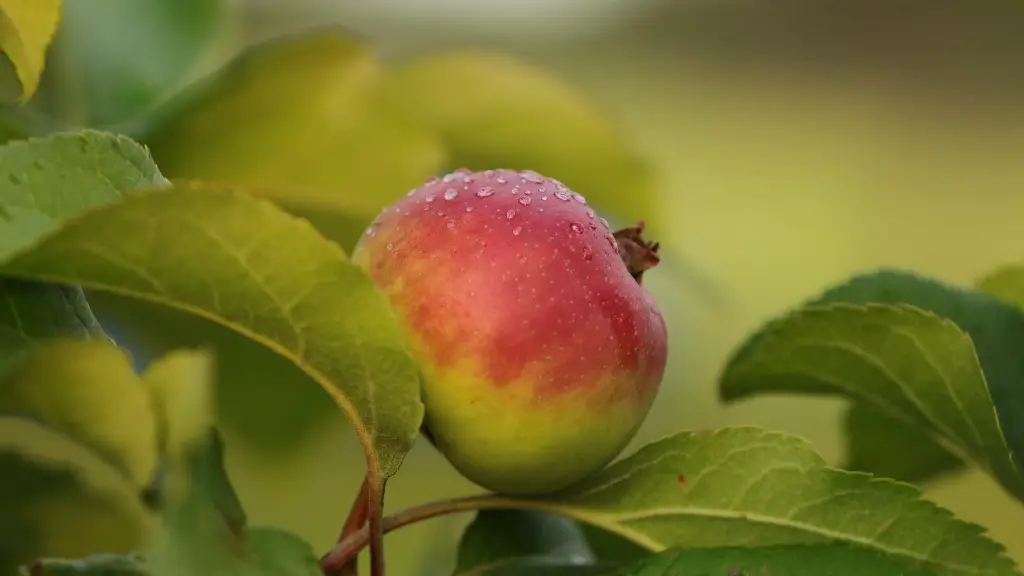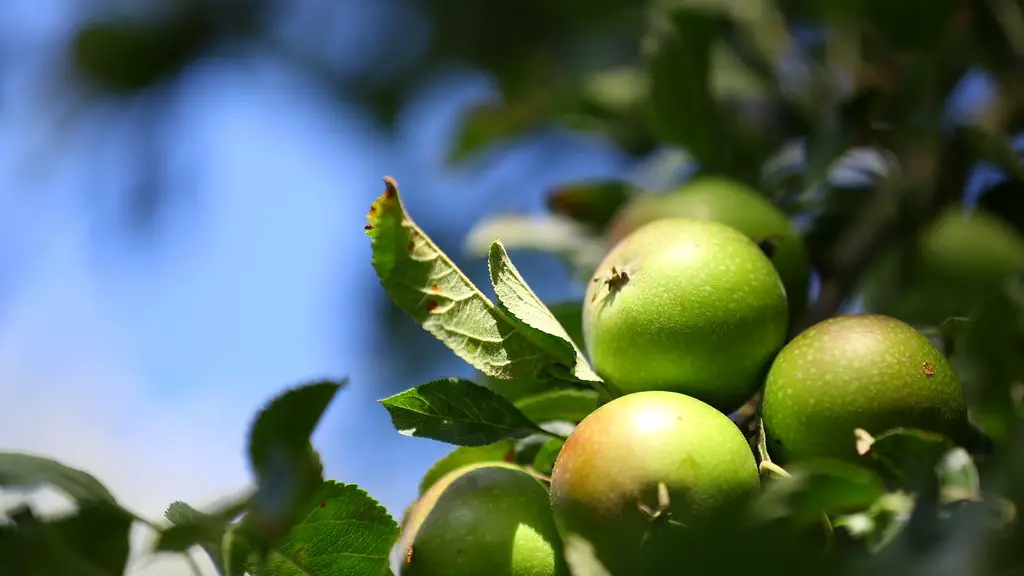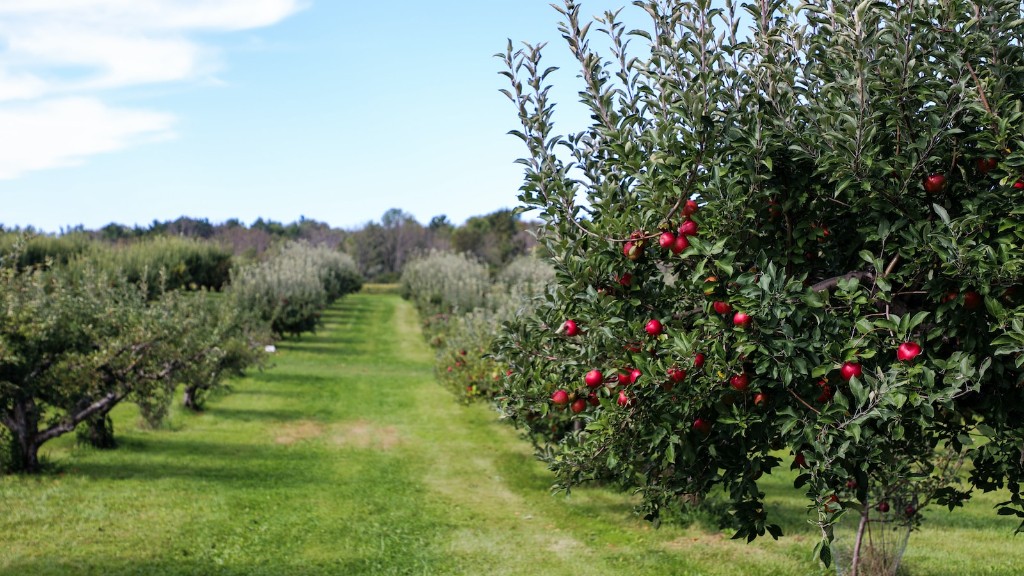1. It’s not uncommon for apple trees to start losing their leaves in June, and it can be a worry for many people. The most common cause of this is environmental stress, which can be due to too little or too much water, insufficient sunlight, extreme temperatures, or harsh chemicals. Nutrient deficiencies can also result in leaf loss, particularly in younger trees that haven’t fully established a clear nutrient balance. Poor soil can prevent trees from taking up enough nutrients, leading to leaf yellowing and falling.
2. If your apple tree is losing leaves in June, the first step is to check for signs of disease. Common apple tree diseases, such as apple scab, can cause leaves to yellow and then drop off early in the season. Insect pests, such as aphids and scales, can also cause leaves to yellow and fall off. Taking a tour of your tree and checking for pests and signs of disease is an essential part of understanding why your apple tree is losing its leaves in June.
3. Once you’ve eliminated any pest or disease issues, it’s time to look at environmental stressors. In general, apple trees need plenty of sunlight, good soil and water, and appropriate temperatures. Make sure you’re providing your tree with the amount of sunlight and water it needs and adjust accordingly if it is not getting enough or too much of either. Soil tests can also be useful for determining if there are any nutrient imbalances that need to be addressed.
4. If your apple tree is still losing leaves in June and the environmental conditions are correct, it may be time to prune the tree. Pruning can improve air circulation and sunlight penetration and can help the tree access more water and nutrients. Make sure to use the right pruning techniques and to trim away any dead, dying, or damaged branches before removing anything else.
5. Another potential cause of your tree losing its leaves in June is age. Apple trees can naturally start to shed more leaves with age, and some older specimens may lose more than younger ones. If your tree is over five years old, consider consulting an arborist to determine the optimal trimming strategy for your particular tree.
Signs of Disease
1. When you notice that your apple tree is losing its leaves in June, the first thing to do is to check for signs of disease. Common apple tree diseases that can cause leaves to yellow and drop off include apple scab, powdery mildew, and fire blight. In addition, various insect pests, such as aphids and scales, can also be a major cause of leaf loss in June. Thus, it’s important to carefully inspect the tree and its leaves before taking any remedial action.
2. A visual inspection of the leaves can help diagnose any disease or pest problem. If the leaves are small, discolored, curl, or have bumps or spots, then it’s likely that your tree is being affected by something other than environmental stress. In this case, it’s important to consult a professional to help identify the problem and offer solutions.
3. In addition to a visual inspection, it’s also useful to inspect the soil and branches for any abnormalities. If you find any poor or waterlogged soil, compacted soil, or abnormal growth patterns in the branches, then it’s likely that your tree is losing its leaves for some underlying issue. Careful inspection of your apple tree can help identify the cause of leaf loss in June, so it’s important to conduct this process as soon as possible.
4. If you can’t find any signs of disease, insect infestation, or environmental stress, then it’s likely that the tree is simply too old. Apple trees can naturally start to shed their leaves with age, so it’s important to consider the age of your particular tree before pursuing any other options. If the tree is over five years old, you may want to bring in an arborist to better understand the cause of the leaf loss and determine the best course of action.
5.In some cases, apple trees may also keep shedding their leaves in June due to transplant shock. If your tree was recently transplanted, then it’s possible that the shock of the move is causing the leaves to fall off prematurely. To help alleviate this problem, make sure that the tree is well-watered and that the soil has been given adequate time to settle.
Environmental Stress
1. Environmental stress can be another major cause of leaf loss in June. Too much or too little water and sunlight, as well as extreme temperatures, can put a significant strain on apple trees and cause them to start dropping their leaves. Thus, it’s important to provide your tree with the essential elements it needs to stay healthy and ensure that it isn’t under any environmental stressors.
2. In addition, it’s also important to check the soil for adequate nutrient levels. Poor soil can hinder the tree’s ability to take up the necessary nutrients, leading to yellowing and shedding of leaves. If you believe that your soil might be an issue, it’s a good idea to do a soil test to identify any nutrient deficiencies. Once you’ve identified the nutrients that are lacking, apply organic amendments to help restore balance back to the soil.
3. Additionally, apple trees may be losing their leaves due to strong winds, heavy rains, or other weather-related events. By providing your tree with adequate shelter from the elements, you can help protect it from some of these environmental stresses. If your tree is in an exposed area, consider using a windbreak or some other form of shelter to help limit the amount of wind and rain it’s exposed to.
4. Finally, it’s also possible that your apple tree is being affected by harsh chemicals. Common culprits can include fertilizers, pesticides, and herbicides. If you’ve recently applied any of these to your garden, it’s possible that your tree is being negatively impacted. Make sure to always follow the safety instructions and only use chemical products when absolutely necessary.
5. If your apple tree is losing its leaves in June, the first step is to identify any underlying issues or environmental stressors. Check for signs of disease and insect infestation, as well as any nutrient deficiencies or harsh weather events. By taking the time to assess your apple tree’s condition, you can figure out why it’s losing its leaves and take the appropriate steps to rectify the problem.
Pruning Strategies
1. If environmental stress isn’t the cause of your apple tree’s leaf loss in June, then it may be time to look into pruning strategies. Pruning can help improve air circulation and sunlight penetration, making it easier for your tree to access the water and nutrients it needs to stay healthy. Make sure to use the right pruning techniques and to remove any dead, dying, or diseased branches before pruning anything else.
2.Younger apple trees tend to benefit from light periodic pruning a few times each year. Focus on removing branches that are taking up resources unnecessarily and any that appear overly dense. As your tree matures, you can begin to thin branches in order to keep the canopy open and help the tree access both sun and air. Avoid over-pruning though, as this can cause weaker tree growth and even greater leaf loss.
3.In some cases, plants may respond best to more intense pruning practices such as crown reduction and pollarding. Crown reduction can involve trimming back several-year-old growth up to a single ring of branches. This technique can help maintain tree size and reduce the need for drastic pruning every few years. Pollarding involves pruning a tree down to a single trunk, which can help reduce its overall height and outward spread. Both techniques should be undertaken by a qualified arborist who can properly assess the situation and provide the best recommendations.
4. Proactive pruning can also be beneficial for more mature apple trees, as it can help to keep them healthy for a longer period of time. Focus on removing dead, dying, and diseased branches, as well as any that are growing towards the inside or centre of the tree. Also, look for any sap or sooty growth and remove these branches as well. Be sure to examine the entire tree and make sure to only prune very little at a time.
5.If your apple tree is losing its leaves in June, it’s possible that pruning could be the solution. By taking the time to properly prune your apple tree, you can help to ensure that it’s able to access the nutrients, air and sunlight it needs to remain healthy. Start by removing any dead, diseased, or damaged branches and then move onto thinning and clearing the centre of the tree. Make sure to prune only a small amount at a time though and be sure to bring in a qualified arborist to help with more intensive pruning tasks.




